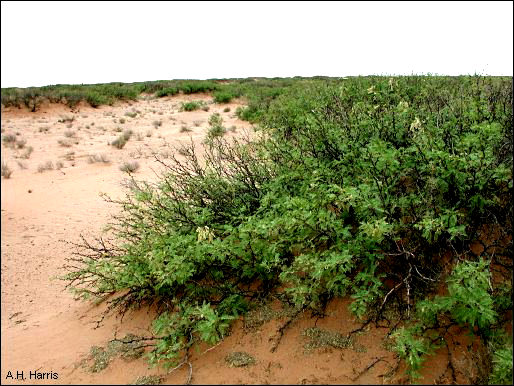

Features characteristic of many areas of the Chihuahuan Desert, such as the Tularosa Basin of southern New Mexico, are fields of mesquite hummocks. These are large mounds of sand topped by shrubby mesquite plants and rising abruptly from a nearly flat plain. Some people find the view somewhat comical, as if the ground surrounding the plants had sunk, leaving the shrubs marooned on islands of sand.
In truth, the process was quite different. Because of over grazing and
drought, stabilizing desert grasses and herbs died, leaving sand to blow around as it
might. Mesquite plants, deep-rooted and thus able to tap into ground water, took hold.
However, the very presence of a shrub interrupted the force of the wind, depositing the
blowing sand around its base. The mesquite avoided being entirely buried only if its
upper parts grew at least as fast as the buildup of sand. Thus, over the years, older
parts were buried and only the uppermost branches remained exposed—now perched on
top of the sandpile monster it created—a monster foiled only by continued
flight!

Contributor: Arthur H. Harris, Laboratory for Environmental Biology, Centennial Museum, University of Texas at El Paso.
Desert Diary is a joint production of the Centennial Museum and KTEP National Public Radio at the University of Texas at El Paso.

Mesquite hummocks west of La Union, Doña Ana County, NM. Photograph by A.H. Harris.